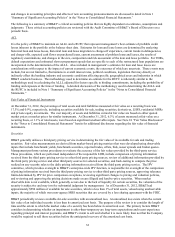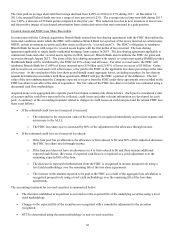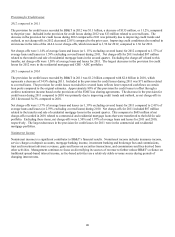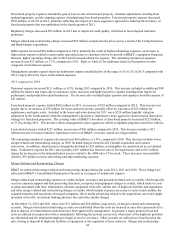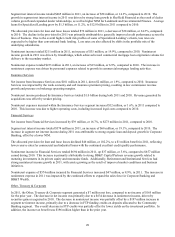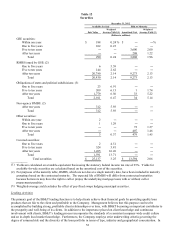BB&T 2012 Annual Report Download - page 64
Download and view the complete annual report
Please find page 64 of the 2012 BB&T annual report below. You can navigate through the pages in the report by either clicking on the pages listed below, or by using the keyword search tool below to find specific information within the annual report.42
the provision for covered loans. Covered loans have experienced better performance than originally anticipated, which has
resulted in the recognition of additional interest income on a level yield basis over the expected life of the corresponding
loans. A significant portion of this increase in interest income is offset by a reduction in noninterest income recorded in
FDIC loss share income. For 2012, noninterest income was reduced by $271 million related to improvement in loan
performance, compared to a reduction of $297 million in 2011. These decreases in income were partially offset by increases
of $11 million and $57 million, respectively, which reflected 80% of the provision for credit losses recorded on covered loans
for 2012 and 2011.
BB&T recognized $12 million in net securities losses during 2012, compared to $62 million of net securities gains in 2011.
The net securities losses during 2012 included $9 million of OTTI charges and $3 million of net losses realized from
securities sales. The net securities gains during 2011 included $174 million of net gains realized from securities sales and
$112 million of OTTI charges. The OTTI charges recognized during 2011 were due to weaker actual and forecasted
collateral performance for non-agency RMBS. Refer to the “Analysis of Financial Condition – Investment Activities”
section for a detailed discussion of strategies executed during the years presented.
Other income increased $105 million in 2012 compared to 2011, primarily due to $149 million of losses and write-downs
recorded in 2011 related to the sale of commercial NPLs. This increase was partially offset by $42 million of increased
write-downs on affordable housing investments in 2012 due to revised estimates and processes used to value these
investments.
2011 compared to 2010
Noninterest income was $3.1 billion for 2011, down 21.3% compared to 2010. The decline in noninterest revenue was due to
fewer securities gains, lower income related to the FDIC loss share receivable, lower service charges on deposit accounts and
lower mortgage banking revenues, while bankcard fees and merchant discounts and trust and investment advisory revenues
grew compared to the prior year. The major categories of noninterest income and fluctuations in these amounts are discussed
in the following paragraphs. These fluctuations include the impact of acquisitions.
Insurance income was up slightly in 2011 compared to 2010, as pricing for premiums remained soft throughout the year.
Service charges on deposit accounts totaled $563 million in 2011, a decline of $55 million, or 8.9%, compared to 2010. The
decrease in 2011 was largely a result of a decline in overdraft fees as a result of mid-2010 changes to BB&T’ s overdraft
policies that were partially in response to new regulation. In 2011, management implemented pricing changes for routine
services related to retail and commercial transaction deposit products, such as monthly maintenance fees and check enclosure
fees, which partially offset the reduction in overdraft fees.
Mortgage banking income totaled $436 million in 2011 compared to $521 million in 2010, a decrease of $85 million. This
decrease was primarily due to a decline of $97 million in residential mortgage production revenues due to lower volumes and
pricing in 2011 and the decision in the third quarter of 2010 to retain a portion of 10 to 15 year mortgage production. This
decline was partially offset by higher servicing revenues as a result of growth in the servicing portfolio and higher revenues
from commercial mortgage banking revenues. Included in mortgage banking income for 2011 is a negative valuation
adjustment of $341 million related to changes in assumptions for residential MSRs that are carried at fair value. This was
more than offset by gains of $394 million from derivative financial instruments used to manage the economic risk.
Approximately $284 million of the decline in the valuation of the residential MSRs was due to increases in the prepayment
speed assumption as a result of a decrease in interest rates. During 2011, management also revised its servicing cost
assumption based on changes to regulations and industry standards that impact the mortgage servicing industry. The change
in the servicing cost assumption resulted in a decline of approximately $30 million in the valuation of the mortgage servicing
asset.
Investment banking and brokerage fees and commissions decreased $19 million, or 5.4%, compared to 2010. This decrease
was largely due to weaker market conditions during the year and a record fourth quarter in 2010.
Checkcard fees decreased slightly in 2011 compared to 2010, due to the Durbin Amendment to the Dodd-Frank Act. The
decrease resulting from the implementation was more than offset by higher volumes during the year.
Bankcard fees and merchant discounts increased $27 million in 2011. The increased bankcard fees were the result of higher
volumes for both retail and commercial bankcard activities.
Trust and investment advisory revenues are based on the types of services provided as well as the overall value of the assets
managed, which is affected by stock market conditions. In 2011, trust and investment advisory revenues increased $14
million, or 8.8%, due to improved market conditions.


